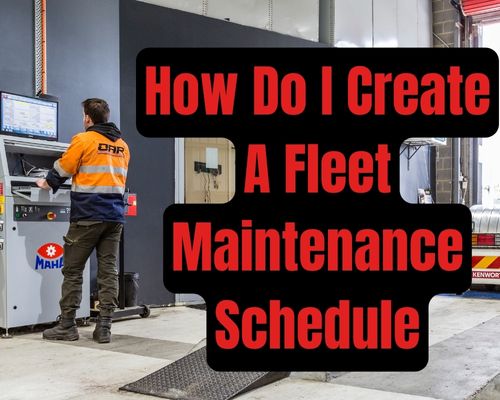
Creating a fleet maintenance schedule starts with a thorough assessment of your vehicles. You’ll need to catalogue each vehicle’s make, model, mileage, and service history to pinpoint maintenance needs effectively. It’s crucial to focus on compliance with both manufacturer guidelines and regulatory requirements to avoid penalties and maintain safety. By integrating a fleet management software, you can automate service reminders and streamline your scheduling process. But how exactly do you select which maintenance approach fits best for different types of vehicles in your fleet, and what are the implications of choosing one method over another? Let’s explore these critical decisions together.

To effectively tailor your fleet maintenance schedule, start by conducting a thorough assessment of each vehicle in your inventory. Dive deep into each vehicle’s history, usage patterns, and operational needs. You’ll need to compile a detailed inventory, categorising vehicles by type, usage, and criticality. This step isn’t just about knowing what vehicles you have, but understanding how each one contributes to your overall operations.
When categorising, consider factors such as the vehicle’s role in your fleet, mileage, and typical load capacity. A heavy-duty truck used daily over long distances has different maintenance needs compared to a lightly used compact car. It’s also important to assess the operational environment—vehicles used in harsh conditions may require more frequent checks.
Your inventory should serve as a dynamic tool in your maintenance strategy, not just a static list. It’s essential for ensuring that you don’t just react to breakdowns but proactively manage the health of your fleet. This initial groundwork lays the foundation for a maintenance schedule that minimises downtime and optimises vehicle performance, keeping your operations smooth and compliant with industry standards.
You’ll need to define specific maintenance needs for each vehicle category to guarantee compliance and optimize fleet performance. Start by conducting a thorough assessment of your fleet to understand the demands of each vehicle.
Here’s a practical guide to help you categorize and determine these needs effectively:
Selecting the right maintenance methods, whether preventive, predictive, or corrective, is essential for keeping your fleet running smoothly and efficiently. You’ll need to understand the specific requirements of each vehicle in your fleet to make informed decisions. Start with preventive maintenance, which includes regular checks and replacements at predetermined intervals based on manufacturer recommendations or past experience. This approach helps prevent vehicle breakdowns and extends the lifespan of your fleet.
Predictive maintenance, on the other hand, requires you to harness data and analytics to foresee potential failures before they occur. This method relies heavily on the integration of technology, such as telematics, which monitors vehicle conditions in real-time, allowing you to act swiftly and avert costly repairs.
Lastly, corrective maintenance is inevitable despite your best efforts. It deals with the repair or replacement of parts as issues arise. While it’s reactive, ensuring a quick and efficient corrective process minimizes downtime and maintains operational continuity.
Balancing these methods according to your fleet’s unique needs and operational demands is vital. Each has its place, and neglecting any can lead to increased operational costs and reduced vehicle availability. So, tailor your approach carefully to maintain peak fleet performance.
Creating a clear and organised maintenance schedule guarantees that each vehicle receives timely attention and stays in peak condition. Here’s how you can develop this essential component of fleet management:
After establishing your maintenance schedule, it’s important to focus on efficiently allocating resources like skilled technicians and necessary tools to guarantee that your fleet operates smoothly. You’ll need to make sure that each maintenance task is properly resourced to minimize downtime and enhance fleet productivity.
Start by evaluating the specific needs of each vehicle in your fleet. Different vehicles may require different skills and tools, so it’s crucial to match these elements accurately to avoid maintenance delays.
Assign your skilled technicians based on the complexity of the tasks at hand. Make certain that all necessary tools and parts are available and easily accessible to avoid any unnecessary delays. It’s also crucial to take into account the location and availability of your maintenance facilities to optimize the logistics of moving vehicles in and out for service.
To maintain a competitive edge, you gotta regularly provide your technicians with training and development opportunities that enhance their skills and knowledge in vehicle maintenance and repair. The rapid advancement in vehicle technologies demands that your technicians stay updated, not just for compliance but also for efficiency and safety.
Here’s how you can strategically enhance their skills:
You’ll need to analyse fleet maintenance data meticulously to pinpoint trends and optimise your schedule accordingly. Start by reviewing historical maintenance records and real-time data from telematics and electronic Daily Vehicle Inspection Reports (eDVIR). This approach helps you understand which vehicles require more frequent servicing based on their usage patterns and operational conditions.
To update your maintenance schedule effectively, focus on the data that indicates vehicle performance and wear. For instance, if certain trucks consistently show early signs of wear in brakes or tyres, adjust their maintenance intervals to prevent breakdowns and costly repairs. Use the insights from telematics to monitor vehicles in real-time, ensuring you’re not scheduling maintenance too early or too late.
Regularly revisiting and revising your maintenance timetable is essential. As you integrate new data, look for changes in vehicle performance that may suggest new maintenance needs. This ongoing process not only enhances efficiency but also helps in complying with safety regulations and reducing operational costs.
To make sure your fleet runs smoothly, start by thoroughly assessing each vehicle and grouping them based on type and usage. Choose the most suitable maintenance methods—preventative fleet maintenance, predictive, or corrective.
Create a precise schedule using fleet management software and set automatic service reminders. Use resources wisely and constantly improve technician skills.
Regularly update your maintenance plan with new data from telematics and eDVIR, staying compliant and proactive. This strategic approach reduces downtime and maximizes fleet performance.